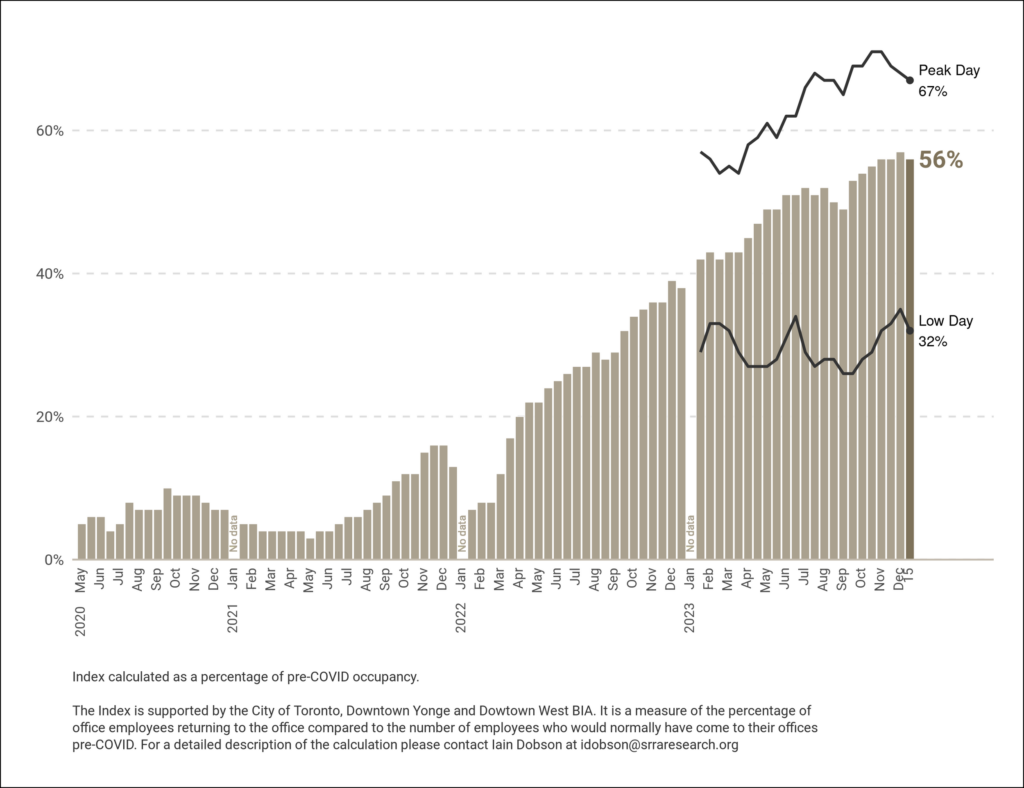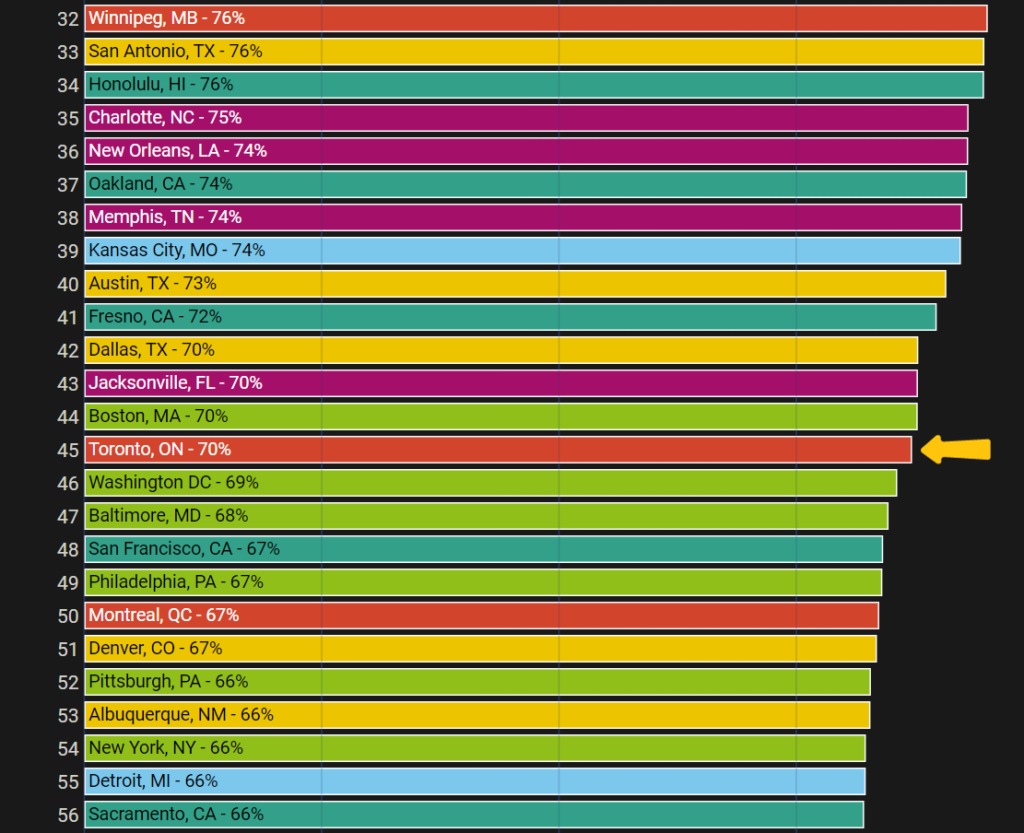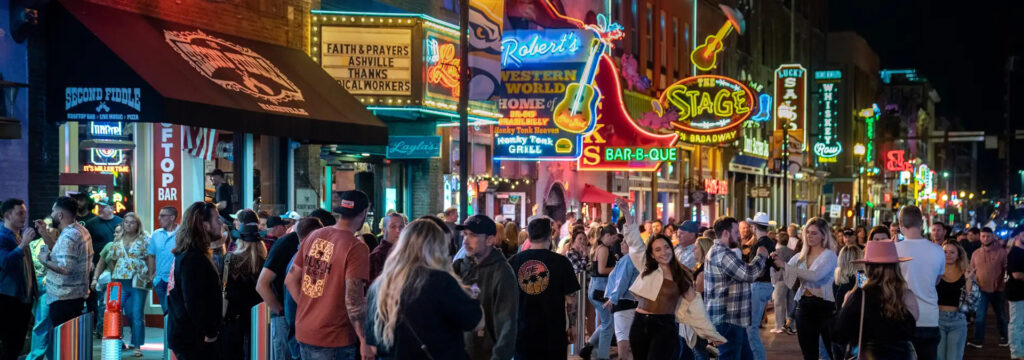Why visitors matter in Toronto's downtown recovey
Office occupancy in Toronto in November 2023 was just 56 percent of what it was in June 2019, according to an ongoing tracking index from Strategic Regional Research Alliance, based on data from the City of Toronto, Downtown Yonge, and Downtown West Business Improvement Areas (or BIAs). Peaking on Wednesdays at 71 percent of pre-pandemic levels, office occupancy in downtown was just 32 percent of its 2019 level on Mondays. Around the same time those numbers were released, Michael Cooper, the CEO of Dream, which owns and operates 17 downtown Toronto office buildings, told the Globe and Mail that as many as 30 percent of Toronto’s office buildings could be considered obsolete.

Back in in the spring of 2023, Toronto ranked a dismal 58th of 62 North American cities, with activity hovering around just 42 percent, according to the Downtown Recovery Index developed by my colleagues at the University of Toronto’s School of Cities. Based on cell phone data which tracks activity levels at downtown points of interest, it found activity in Toronto’s downtown in the second quarter of 2023 to be just 42 percent of what it was before the pandemic. At the time, Toronto lagged every other Canadian city covered, including Winnipeg, Ottawa, Edmonton, Halifax, and nearby London and Mississauga, and it was considerably behind the downtowns of large U.S. cities like New York, Washington DC, Los Angeles, Chicago, and Miami, and even hard-pressed Rustbelt cities like Detroit. Only five cities had downtowns that were worse off than Toronto’s: Indianapolis, Minneapolis, Portland, Oregon, and San Francisco. The last two were not only contending with the challenges of hybrid and remote work, but with significant homelessness, vagrancy, crime, and urban disorder.
But things have improved more recently, according to an updated version of the index released in October 2023, which found that Toronto’s downtown activity had returned to 70 percent of pre-pandemic levels. Its downtown now ranked 45th of the 66 North American downtowns covered . Still, Toronto lagged all but one other Canadian city, Montreal, and was considerably behind Mississauga, Quebec, Vancouver, Calgary, Halifax, Ottawa, and Edmonton. It also was far behind the recoveries of U.S. downtowns like Las Vegas, Miami, Nashville, and Los Angeles. It was still just slightly better than San Francisco’s.

Toronto’s downtown can no longer depend on commuters and residents for their economic health. Visitors play an increasingly critical role, adding much-needed vibrancy and providing critically needed revenue. According to a recent comprehensive study of 26 of the largest American downtowns, visitors account for a whopping 62 percent of downtown activity, significantly more than residents, who account for 11 percent of activity, and office workers, who account for 27 percent. The cities that have recovered the most, the study concludes, are those “with the highest share of daily visitors downtown in 2019.”
Though Toronto was not included in that study, other data suggests that the city and its downtown are seriously lagging on this score. Visitors to Toronto were at 72 percent of their pre-pandemic levels as of 2022, the date for which the most recent data are available. The figure for international visitors was significantly worse, hovering at roughly 50 percent of their pre-pandemic levels. And Toronto had a serious deficit of international visitors even before the pandemic. According to a detailed 2018 study of its visitor economy, 85 percent of Toronto’s 27.3 million visitors were from Canada, 9 percent were from the US, and only 6 percent were from other countries. Most of its visitors, more than 70 percent of them, were day-trippers who did not spend a single night in the city.
One recent bright spot for Toronto: hotels in the city’s downtown core are recovering better than either office or retail properties, according to the most recent research by my colleagues at the School of Cities. This analysis, which breaks out Toronto’s downtown recovery by building type covers more than 100 buildings in Toronto’s downtown Financial District. Most of these buildings are either office (45%), mixed-use office and retail buildings (33%), or retail-only (11%) buildings, with 7 percent being hospitality buildings. The median recovery rate for hospitality buildings was 133 percent compared to 69 percent for office buildings, 56 percent for mixed office and retail buildings, and 55 percent for retail only buildings. This signals the relevance of visitors for the ongoing recovery of Toronto’s downtown core and adjacent areas.
Nashville is the city that best illustrates the key role played by visitors. Its downtown was the only one of the 26 US downtowns in the US study that has higher activity levels now than it did before the pandemic. It is also the only city where visitor activity exceeds pre-pandemic levels. Visitors from outside the region play the most important role. While Nashville ranks fourth on its recovery of local visitors, it ranks first on visitors who come from outside the region, who now exceed its pre-pandemic baseline by 17 percent.

To attract more visitors, downtown expert N. David Milder argues that cities must focus on improving their older destinations and creating exciting new ones. Downtowns “have been resting on their laurels and too many of the attractions downtown leaders have seen as strong and unique have in fact lost their luster and a significant amount of their magnetism,” he writes. “These old attractions/destinations now need a hard-headed assessment, and then where required they should be improved or replaced. People come downtown based on the strength and convenience of its attractions.” That advice seems especially important for Toronto today.

